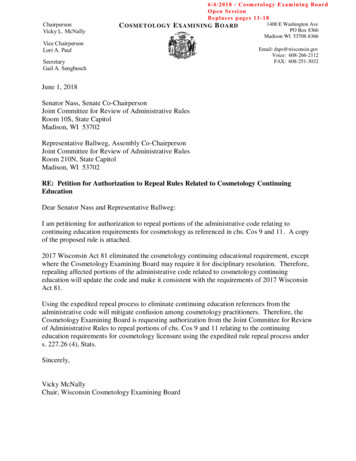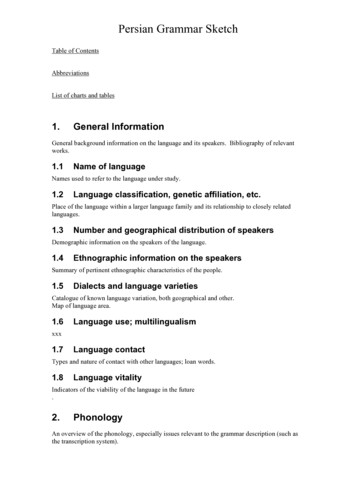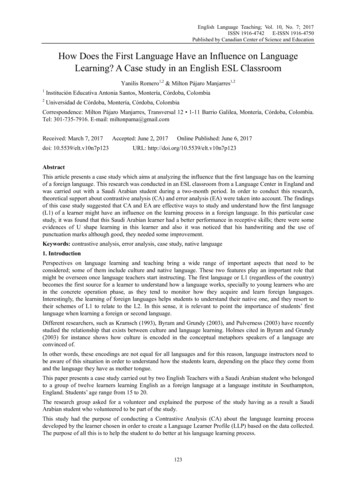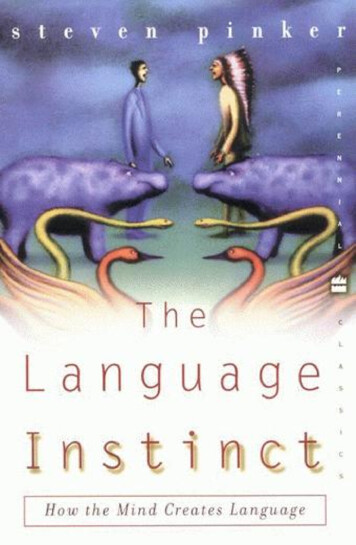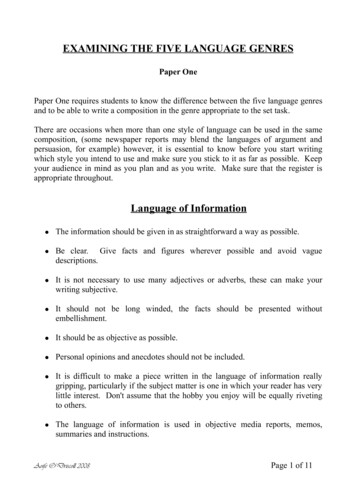
Transcription
EXAMINING THE FIVE LANGUAGE GENRESPaper OnePaper One requires students to know the difference between the five language genresand to be able to write a composition in the genre appropriate to the set task.There are occasions when more than one style of language can be used in the samecomposition, (some newspaper reports may blend the languages of argument andpersuasion, for example) however, it is essential to know before you start writingwhich style you intend to use and make sure you stick to it as far as possible. Keepyour audience in mind as you plan and as you write. Make sure that the register isappropriate throughout.Language of Information The information should be given in as straightforward a way as possible. Be clear. Give facts and figures wherever possible and avoid vaguedescriptions. It is not necessary to use many adjectives or adverbs, these can make yourwriting subjective. It should not be long winded, the facts should be presented withoutembellishment. It should be as objective as possible. Personal opinions and anecdotes should not be included. It is difficult to make a piece written in the language of information reallygripping, particularly if the subject matter is one in which your reader has verylittle interest. Don't assume that the hobby you enjoy will be equally rivetingto others. The language of information is used in objective media reports, memos,summaries and instructions.Aoife O'Driscoll 2008Page 1 of 11
The following pieces, taken from internet sites, are examples ofinformative writing.ANIMAL TESTINGAnimal testing / animal experimentation is the use of non-human animals in scientificexperimentation. It is estimated that 50 to 100 million vertebrate animals worldwide— from zebrafish to non-human primates— are used annually. Most animals areeuthanised after being used in an experiment.The research is conducted inside universities, medical schools, pharmaceuticalcompanies, farms, defence establishments, and commercial facilities that provideanimal-testing services to industry. It includes pure research such as genetics anddevelopmental biology as well as applied research such as drug testing and cosmetictesting. Animals are also used for education, breeding, and defence research.Supporters of the practice, such as the British Royal Society, argue that virtuallyevery medical achievement in the 20th century relied on the use of animals in someway, with the U.S. National Academy for Science arguing that even sophisticatedcomputers are unable to model interactions between molecules, cells, tissues, organs,organisms, and the environment, making animal research necessary in some areas.The U.S. and British governments both support the advancement of medical andscientific goals using animal testing, provided that the testing minimizes animal useand suffering. Others, such as the British Union for the Abolition of Vivisection,question the necessity of it. These opponents make a range of arguments: that it iscruel, poor scientific practice, cannot reliably predict effects in humans, poorlyregulated, that the costs outweigh the benefits, or that animals have an intrinsic rightnot to be used for experimentation.GUN CONTROLGun politics in the United States, incorporating the political aspects of gun politicsand firearms rights, has long been among the most controversial and intractableissues in American politics. For the last several decades, this debate has beencharacterized by stalemate between debate on an individual's right to firearms underthe Constitution and the duty of government to legislate gun laws to prevent crimeand maintain order. In District of Columbia v. Heller, No. 07-290, the Supreme Courtof the United States held that an individual right to bear arms is protected under theSecond Amendment. Repeated polling has found that a majority of Americans believethat they have a right to own a gun while at the same time a majority also believesthat there is a need for stricter firearm law enforcement. Relative to enacting new gunlaws, however, the support drops to a minority; only 43 percent believe new lawswould be more effective in reducing gun violence in the United States than the betterenforcement of existing laws.Aoife O'Driscoll 2008Page 2 of 11
Language of Argument The language of argument presents a viewpoint and tries to win the reader overby appealing to his or her logic rather than emotion. There is no emotionally charged language used, the tone is quite calm andlogical. The evidence is presented and the reader is encouraged to make up his or herown mind. Analogy is a useful tool here, (a comparison between two things which areotherwise dissimilar). Questions are commonly used to engage the reader and to try to make him orher believe that there is a dialogue taking place between two like-mindedindividuals. Facts and figures are given, as in the language of information, but they arecarefully chosen to support the point the writer is making. It is acceptable to anticipate and briefly respond to the reader's possibleobjections to the argument you are putting forward but be careful that you don'tweaken your case by doing so. Giving both sides of the argument equal weightis not a good idea. Just because the language of argument doesn't try to win the reader over withemotion doesn't mean that the writer doesn't have a strong opinion themselves,it simply means they give all the points in favour of their argument and trustthe reader will be intelligent enough to weigh the evidence and come to theright conclusion. The language of argument is used in certain newspaper reports, scientificjournals and legal documents.Aoife O'Driscoll 2008Page 3 of 11
The following pieces, taken from an internet site, are examples of thelanguage of argument. I have edited them as the originals would havetaken too long to read in a lesson.The Scientific Argument Against Animal TestingThe most commonly held perception regarding animal experimentation is that it isnecessary for the development of vaccines, cures and treatments for human illness.Proponents ask the important question, what will happen to research on AIDS, heartdisease, and cancer if animal experimentation is completely stopped? Will theprogress in cures and treatments for these types of illnesses also come to a halt?There is a growing movement of healthcare professionals including doctors,scientists, and educated members of the public who are opposed to non-humananimal-based experimentation on specifically medical and scientific grounds. Theyargue that animal research is based on a false premise, that results obtained throughanimal experimentation can be applied to the human body.Animals not only react differently than humans to different drugs, vaccines, andexperiments, they also react differently from one another. Ignoring this difference hasbeen and continues to be very costly to human health.What about all the important breakthroughs, as a result of animal research, that haveaided human health? The animal research industry cites many examples of treatmentsor cures for illness that have been found using animals. They claim that if animalresearch is discontinued, it will be at the expense of human health and life. Industrygroups, such as Americans for Medical Progress credit animal research with advancessuch as the development of the polio vaccine, anaesthesia, and the discovery ofinsulin. But a close examination of medical history clearly disputes these claims.Surgical anaesthesia was discovered in the mid nineteenth century when CrawfordWilliamson Long observed the effects of ether on humans during "ether parties", apopular form of entertainment involving ether inhalation. Long observed that whileetherized, people appeared impervious to pain. He transformed this observation into amore practical use in surgery. The discovery of anaesthesia, like many other medicaldiscoveries, came from the critical observation of humans.Clearly, if we are going to make medical progress, a new approach is needed. Humanmedicine can no longer be based on veterinary medicine. It is fraudulent anddangerous to apply data from one species to another. There are endless examples ofthe differences between humans and non-human animals.1. PCP is a sedative for chimps2. Penicillin kills cats and guinea pigs but has saved many human lives.3. Arsenic is not poisonous to rats, mice, or sheep.Aoife O'Driscoll 2008Page 4 of 11
4. Morphine is a sedative for humans but is a stimulant for cats, goats, andhorses.5. Digitalis while dangerously raising blood pressure in dogs continues tosave countless cardiac patients by lowering heart rate.The National Institutes of Health alone pours well over five billion dollars annuallyinto superfluous animal experimentation. Abolishing animal research will mean theseresources could be redirected into prevention and the types of research which actuallyhave a chance of advancing human medicine and human health.Arguments on Gun ControlWith the Second Amendment giving American citizens the right to bear arms, andapproximately fifty percent of Americans owning some form of a firearm, issuesinvolving the ownership and possession of guns have led to heated debates inAmerican society. Most notably is the issue of gun control. Many feel that the someform of gun regulation is necessary in order to lower the level of gun related violencein the country. On the other hand, the opponents of gun control feel that it would bean infringement on their second amendment rights. The outcome and extent of guncontrol has strong political implications because it basically determines the presentday meaning of the Second Amendment. While each side has strong points to theirarguments, one quote by writer Michael Warfel basically sums up the need for guncontrol. He writes, “ an individual’s right to own and bear arms must be balanced bythe greater social needs of a society” . Today, based on the number of crimes andviolent acts committed with guns, society needs more gun control.Aoife O'Driscoll 2008Page 5 of 11
Language of Persuasion The language of persuasion is similar in many ways to the language ofargument. Both outline a case for or against a particular point of view. The difference is that language of persuasion deliberately tries to influence thereader by appealing to his or her emotions, not reason. Manipulation can be a major part of the language of persuasion. It often playson the reader's conscience, making him or her feel guilty or pressurised intoagreeing with the case being made. It can also flatter the reader into agreeing;this is a common technique in advertising, 'As a discerning customer, we knowyou want nothing but the best', etc. Strong, emotive language can be used to win the reader over. The word 'We' is often used instead of 'I' to draw the reader in and make him orher feel on the same side as the writer. Adjectives and adverbs are used freely and they are often quite extreme. The writer's opinion is usually crystal clear from the opening sentence. Facts and figures may be given but they may be vague or exaggerated, 'Thevast majority of people', 'Almost every student in the country', etc. This canaid the manipulative effect of persuasive writing, the implication is often therethat if you don't agree, you are going against popular opinion and you don't fitin. Obviously, this is very useful in advertising. Generalisations are usedwithout the support of a source – watch out for 'All' or 'Every'. Rhetorical questions, an argument framed in the form of a question to whichthere can be only one possible answer, may be used. 'Why should we allowour parents to rule every aspect of our lives?' (Answer expected – weshouldn't.)Aoife O'Driscoll 2008Page 6 of 11
'Persuader' words can be used to good effect:ClearlyPlainlySurelyUndoubtedlyObviously Personal opinion and anecdotes are often used. The language of persuasion is used in advertising, political speeches and somenewspaper reports.Aoife O'Driscoll 2008Page 7 of 11
The following pieces, taken from internet sites, are examples of persuasivelanguage.ANIMAL TESTINGAnimal experimentation involves the incarceration of animals - which itself causesintense psychological distress - who are then poisoned, mutilated, given diseases andkilled. It is arguably the most severe form of systematic violence in the modernworld. Other terms for animal experimentation include 'vivisection', 'animal testing',and 'animal research'.The annual Home Office statistics for vivisection have revealed an appalling rise inanimal experimentation during 2007. It is the sixth yearly increase in succession andthe highest figures since 1991. For the first time in sixteen years, the number ofanimals used topped the 3 million mark. By law, the Home Office only counts thoseexperiments that have the potential 'to cause pain, suffering, distress or lasting harm'.The Government consistently issues blatantly dishonest statements, claiming that UKregulations 'permit only essential research with clear medical benefits'. In fact, thestatistics show that thousands of animals are used in poisoning tests for nonpharmaceutical substances. The Government refuses to ban suffering for unarguablytrivial purposes such as new laundry liquids, and allows painful and traumaticanimals tests for substances like refrigerants and industrial chemicals. Furthermore,the Government admits that they have never actually conducted research to evaluatewhether animal experiments benefit human medicine, despite scientific doubts overtheir applicability and thousands of human deaths caused by drug side-effects notrevealed by previous animal tests.GUN CONTROLOpposition to gun control, once you strip away the grandstanding and chestthumping, amounts to a child's naked need for comfort and safety. Charlton Hestonrecently referenced the popular NRA slogan, "You can have my gun when you canpry it loose from my cold, dead hand." How guns can, ultimately, protect you from alladversaries I'm a little unclear on. I subscribe to an e-mail newsletter that sends metitbits about history. A recent item from this newsletter described an Old West figure,a brilliant gunfighter, a man who could draw, aim and pull the trigger faster thanlighting--and his enemies ambushed him and shot him in the back. No matter howmany firearms a person owns and uses, no matter how good he or she is with them, itis no absolute guarantee of safety. It's a big world, and there's always room enough init for someone who will not play fair.U.S. gun lovers think their weapons give them ultimate safety. I believe DavidKoresh was responsible for his own destruction - but he's still worth mentioning. Hisprivate armoury, and private army, could not save him from the might of thegovernment showing up on his doorstep -ready to destroy him, if necessary.Aoife O'Driscoll 2008Page 8 of 11
Language of Narration This is almost certainly the first type of language most people used in theircompositions when they were younger. In the language of narration, the writer simply tells a story. The story can be fact or fiction. Autobiographies are written in a narrativestyle, they generally present us with the events of the subject's life inchronological order. The set novels on your course are examples of narrative language. The language of narration can and should contain an element of aestheticlanguage.The following example of narrative writing is taken from Peter Mayle's 'A Year InProvence':The whole furtive business began with a phone call from London. It was my friendFrank, who had once been described in a glossy magazine as a reclusive magnate. Iknew him better as a gourmet of championship standard, a man who takes dinner asseriously as other people take politics. Frank in the kitchen is like a hound on thescent, sniffing, peering into bubbling saucepans, quivering with expectation. Thesmell of a rich cassoulet puts him in a trance. My wife says that he is one of the mostrewarding eaters she has ever cooked for.There was a hint of alarm in his voice when he explained why he was calling.'It's March,' he said, 'and I'm worried about the truffles. Are there still some left?'March is the end of the truffle season, and in the markets around us, as close as wewere to the truffle country in the foothills of Mont Ventoux, the dealers seemed tohave disappeared. I told Frank that he may have left it too late.There was a horrified silence while he considered the gastronomic deprivation thatstared him in the face – no truffle omelettes, no truffles en croûte, no truffle-studdedroast pork. The telephone line was heavy with disappointment.Aoife O'Driscoll 2008Page 9 of 11
Aesthetic Language Aesthetic language is used to create images of beauty through carefully chosenwords. It is a common feature of poetry. While it is more usually associated with fiction, aesthetic language can be usedin non-fiction also. Good examples of aesthetic language may be found indescriptions of travel or of nature. It is a good idea to think of the literary terms you learnt for your poetry studieswhen you are considering writing in this style. Images, metaphors and similesand repetition can all be used to advantage here. The language can also be musically pleasing, as in a poem. This is achieved bythe use of assonance, alliteration and onomatopoeia.The following example of aesthetic language is from James Joyce's 'The Dead'.A few light taps upon the pane made him turn to the window. It had begun to snowagain. He watched sleepily the flakes, silver and dark, falling obliquely against thelamplight. The time had come for him to set out on his journey westward. Yes, thenewspapers were right: snow was general all over Ireland. It was falling on every partof the dark central plain, on the treeless hills, falling softly upon the Bog of Allenand, farther westward, softly falling into the dark mutinous Shannon waves. It wasfalling, too, upon every part of the lonely churchyard on the hill where Michael Fureylay buried. It lay thickly drifted on the crooked crosses and headstones, on the spearsof the little gate, on the barren thorns. His soul swooned slowly as he heard the snowfalling faintly through the universe and faintly falling, like the descent of their lastend, upon all the living and the dead.Aoife O'Driscoll 2008Page 10 of 11
Aoife O'Driscoll 2008Page 11 of 11
Language of Argument The language of argument presents a viewpoint and tries to win the reader over by appealing to his or her logic rather than emotion. There is no emotionally charged language used, the tone is quite calm and logical. The evidence is presented and the reader is encouraged to make up his or her own mind. Analogy is a useful tool here, (a comparison File Size: 352KB




